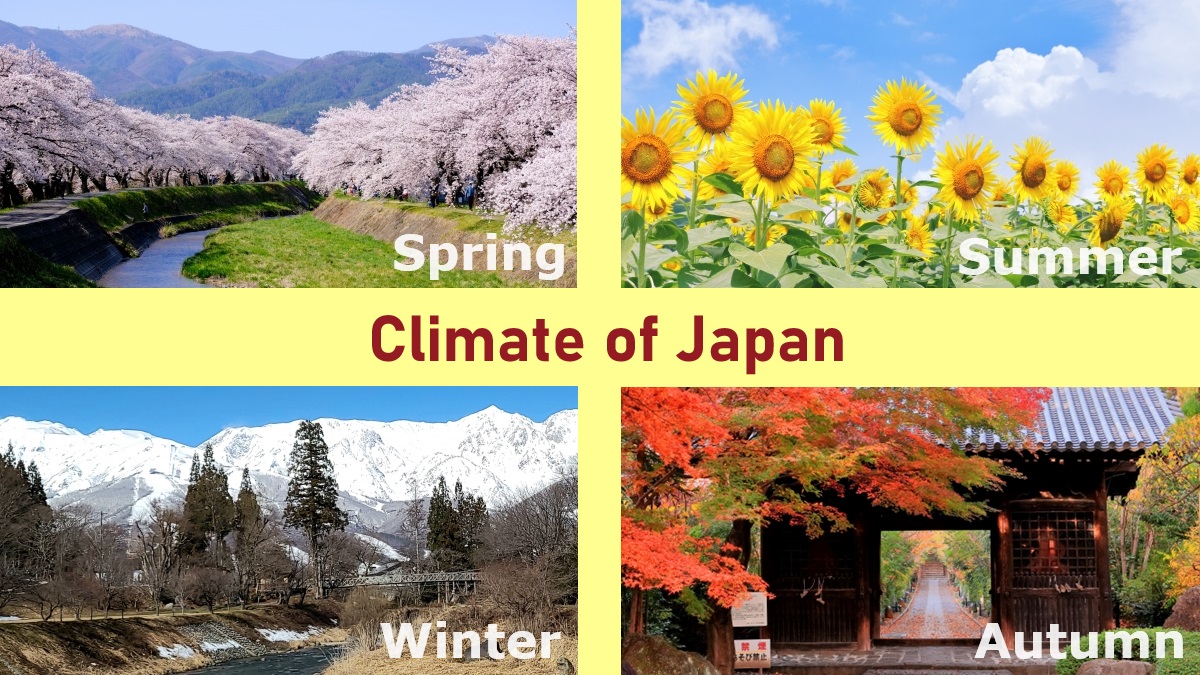Climate of Japan
Outline of climate of Japan
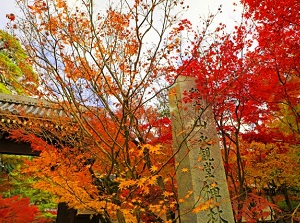
Autumn leaves in Eikando temple in Kyoto
Japan mainly belongs to the temperate zone.
But, the north part such as Hokkaido belongs to the subarctic zone and the climate is similar to northern Europe.
The south part such as Okinawa Islands belongs to subtropics and the climate is similar to Taiwan, Hawaii, the Philippines, etc.
There is extensive continent to the west of Japan.
There is Sea of Japan between the continent and Japan.
And there is vast Pacific Ocean to the east and south.
Warm ocean currents flow northeastwardly off the coast of Japan.
This situation moves the various air masses around Japan, so unique four seasons in Japan are created.
For details, see the following page.
Summer in Japan is getting hotter
The climate of Japan may be suffering from the effects of global warming.
It is obvious that summer in Japan is getting hotter.
In recent years, the areas where the temperature exceed 35 degrees Celsius are increasing and it is over 40 degrees in some areas.
When you travel around Japan in midsummer (July, August), you must be careful of heat stroke.
In addition, localized torrential rain often occurs and causes floods.
At that time, transportation stops sometimes and that may affect your travel.
Because warm weather is getting long, the cherry blossom season is earlier than before and the autumn leaves season is later than before.
(The cherry blossom season is in Tokyo is in late March, and the autumn leaves season in Kyoto is in late November.)
Climate in Honshu, Shikoku, Kyushu Islands
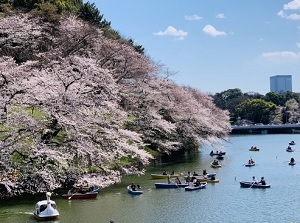
Cherry blossoms in Tokyo
Honshu Island has an arc shape.
The northeast part is long from north to south, and there is Tohoku Region.
The other part is long from east to west, and the east end is Kanto Region including Tokyo.
Because the area is almost on the same the latitude, the climate is also similar.
In the area, spring starts from March, tsuyu (rainy season) continues from mid-June to mid-July.
Midsummer in the mainland of Japan is very hot and humid.
Recently, the temperature in many cities often exceeds 35°C.
Autumn comes around mid-September, and real winter starts in the late December.
In the south side of the area, it is fine and dry in most days in winter.
But the north side of the area facing the Sea of Japan has much snow in winter.
Tohoku Region is a little cooler than the area.
Spring comes 2 to 4 weeks later than Tokyo, and winter comes 2 to 4 weeks earlier than Tokyo.
The climate in Shikoku and Kyushu are also similar to Honshu.
But Shikoku and the south part of Kyushu are warmer than the other areas.
Climate in Hokkaido Island
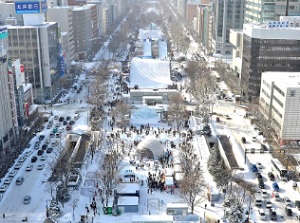
Sapporo Snow Festival in February
Hokkaido is the northernmost region in Japan, so the climate is cooler than the other regions.
Winter starts from late November and ends in late April.
It snows in the whole area, but the southeastern area near coast has less snow than the other area.
In January and February, the temperature in most areas in Hokkaido becomes below the freezing point.
Especially, the temperature in the inland area falls down to 10°C below zero, and sometimes 20 to 30°C below zero.
On the other hand, the temperature in midsummer is unexpectedly high and becomes over 30°C sometimes.
But because the humidity is lower than Honshu, the climate is comfortable.
Climate in Okinawa Islands
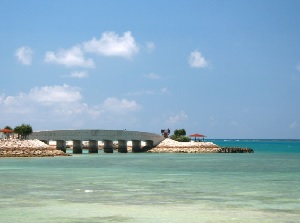
Beach in Okinawa
The islands in Okinawa area belong to the subtropical regions.
Of course, the climate is warm and the area has no cold season.
Snow fell in Okinawa only twice in about 60 years.
Even in midwinter, the temperature in a day is over 15°C.
In summer, the temperature in a day is 30 to 33°C.
But it is lower than the temperature in the mainland of Japan because the small islands are surrounded by wide ocean.
And squalls occured often in summer.
Typhoon
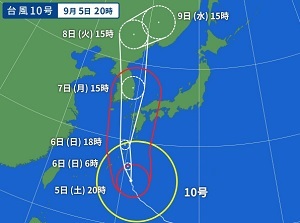
A predicted course of a typhoon in a weather report (Typhoon No.10 on Sep.5, 2020)
There is the vast Pacific Ocean to the south of Japan.
Near the equator of Western Pacific Ocean, more than twenty typhoons develope every year.
"Typhoon" is a strong tropical cyclone in Western Pacific Ocean, and it is the same as "hurricane" in eastern Pacific Ocean and Atlantic Ocean and "cyclone" in South Pacific Ocean and Indian Ocean.
The central atmospheric pressure is extremely low, and very strong wind blows toward the center like a huge whirlpool.
Therefore, fierce storm causes within several hundred kilometers.
In general, a typhoon moves toward the northwest or the west, then it turns toward the northeast or the north at around a latitude of 20 degrees north by westerlies.
The moving speed is 10 to 40 km/h.
Every year, 2 to 6 typhoons hit Japan from southwest or south and pass through the mainland of Japan to northeast or north.
Most of them come to Japan between July and October.
Especially, the typhoons hitting Japan peaks in August and September.
In a place where a typhoon passes, the storm rages for some hours to half day.
Landslide disaster, wind damage and flood often occurs.
After a typhoon is born in the ocean, it reaches Japan in 3 to 7 days.
The weather forecasts on TV and radio say early about detailed information of the typhoon which has a possibility to come to Japan.
Pay attention to the weather forecast when you visit Japan in this season.
If a typhoon is coming, it causes traffic confusion in wide areas in Japan.
Probably you may be forced to change your travel schedule.
By the way, each typhoon has a name of person in most countries, but the ordinal number in the year is given to the typhoon in Japan.

